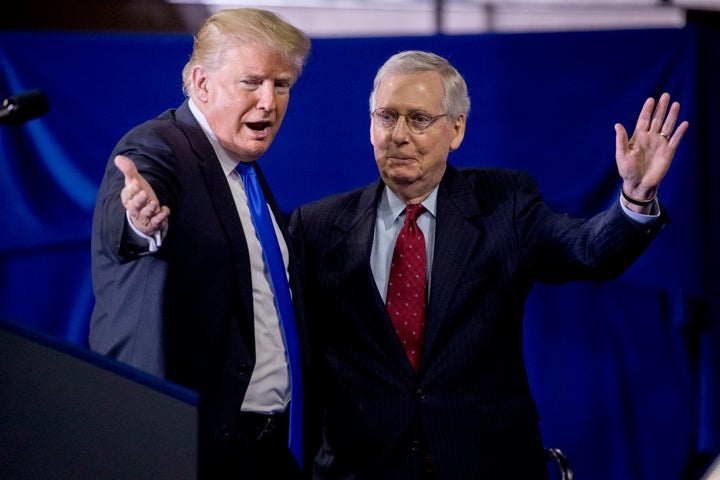
After two years of confirming President Donald Trump’s judicial nominees at warp speed, Republicans just hit a new milestone: They flipped the balance of a U.S. circuit court from a Democratic-appointed majority to a GOP-appointed majority.
When the Senate voted last week to put Paul Matey into a lifetime seat on the U.S. Court of Appeals for the 3rd Circuit, he became its third Trump judge and its seventh Republican pick. Those seven judges named by GOP presidents now outnumber the six judges on the 3rd Circuit named by Democratic presidents.
We’ve spilled a lot of ink at HuffPost about the judges Trump is getting confirmed ― in terms of their sheer numbers (he’s had more circuit judges confirmed by this point in his first term than any other president), their incompetence and their professional backgrounds (they are overwhelmingly young, anti-LGBTQ, anti-abortion, anti-voting rights ideologues).
But where is all this headed? How different will the judiciary look by the end of Trump’s first term? A closer look at the circuit court seats that the president has filled or could fill suggests that he won’t get to replace as many Democratic-chosen judges with his conservative picks as he and Senate Majority Leader Mitch McConnell (R-Ky.) might have hoped.
Russell Wheeler, a visiting fellow in the Brookings Institution’s Governance Studies Program, crunched the numbers on this in December and found that 19 of Trump’s 29 circuit judges were replacing judges selected by other Republican presidents. HuffPost updated his numbers: 24 of the 36 circuit judges Trump has confirmed so far have replaced Republican picks.
What about the circuit court vacancies that Trump could still fill in his first term? Wheeler found in December that nine of 16 current and announced future vacancies were filled by Republican-chosen judges. HuffPost updated his numbers: Five of 10 current and future vacancies were or are still filled by Republican-chosen judges.
In other words, despite Trump’s filling circuit court vacancies like there’s no tomorrow, he’s mostly replacing older Republican-appointed judges with younger ones. And there’s no reason to believe that Democratic-appointed judges will voluntarily create a wave of vacancies over the next year and a half for Trump to fill. That means the current balance of GOP-vs.-Democratic-appointed judges on these courts isn’t likely to look much different by the end of Trump’s term.
“Obviously how that plays out depends on how many more vacancies occur, especially vacancies in seats held by D-appointees,” Wheeler said in an email. “I don’t anticipate many.”

This isn’t to say that Trump isn’t changing the courts. He’s had two Supreme Court justices and 53 district judges confirmed, and he’s put dozens of right-wing ideologues in their 30s and 40s into lifetime seats on circuit courts, which often have the last word in federal cases. The Supreme Court hears only about 100 to 150 appeals from the more than 7,000 cases that come before the nation’s 13 circuit courts each year.
In particularly controversial cases relating to civil rights or reproductive rights, for example, the decisions that Trump’s judges reach as part of the circuit courts’ three-judge panels could make all the difference.
But for all the energy that Trump and McConnell are putting into tilting the nation’s circuit courts in a more conservative direction, they aren’t shifting the majority balance on the courts just yet.
“It does seem that many circuit judges appointed by Democratic presidents will not assume senior status or retire until after the 2020 elections,” said Carl Tobias, a University of Richmond law professor and expert on judicial nominations. “If Trump wins re-election, the majorities on more circuits would be in play.”
Besides the 3rd Circuit, the only other circuit court that Trump could easily flip is the 11th Circuit, which has six Democratic-appointed judges and six GOP-appointed judges. But there aren’t any vacancies on that court right now. The balance of Republican-vs.-Democratic appointed judges on all the other circuit courts isn’t changing anytime soon: The 5th, 6th, 7th and 8th Circuits have GOP majorities, and the 1st, 2nd, 4th, 9th, 10th, D.C. and Federal Circuits have Democratic majorities.
Of course, the party of the president who names a judge is only one predictor of how that judge might approach cases. Each judge has to consider the law, the facts and the specific issues at play in every case that comes before them.
That doesn’t mean there isn’t a clear theme linking the judges that Trump has picked, though.
“Obviously, someone who wants courts of appeals to decide cases [in favor of] the civil rights claim, environmental claim, gender/reproductive rights claims, etc. will not be happy as Trump puts more judges on the courts of appeals,” said Wheeler.
